
T52 – the Sherman with a Ball Turret
This is the second Sherman-based self-propelled anti-aircraft gun we’ve looked at – they are just too cool and unusual to ignore! It is the T52, which is a Sherman paired with a 40 mm in a ball-type turret.
Very little information is available on this vehicle, so this will only be a brief overview of this weird creation.
Background
The need for self-propelled anti-aircraft guns (SPAAGs) increased suddenly during the Second World War. Aircraft had become more adept at the ground-attack role, and were now a much larger threat.
Even if they didn’t cause much physical damage, they had a huge psychological impact on troops. To defend moving columns of equipment and troops from aircraft, SPAAGs were necessary.
Of course, the SPAAG was not a new concept, with the type having its origins in the First World War, but by the 1940s they were in much higher demand. The US got to work on this problem early, applying the lessons being learned from the events happening in Europe before they themselves were even involved in the war.
The M16 multiple gun motor carriage. These vehicles served throughout WWII, and even the Korean War.
This effort would produce successful vehicles like the M16, which was a half-track that carried four .50 caliber machine guns in a rear-mounted turret. However they were lacking in armor, and more importantly, lacked the mobility of tanks.
A tank-based SPAAG would have more armor, and be able to keep up with tanks as they advanced.
In 1941 the US began a project that attempted to mount a 75 mm anti-aircraft gun on the chassis of an M3 medium. This would gradually morph into the 40 mm Gun Motor Carriage T36, another strange creation that deserves an article of its own.
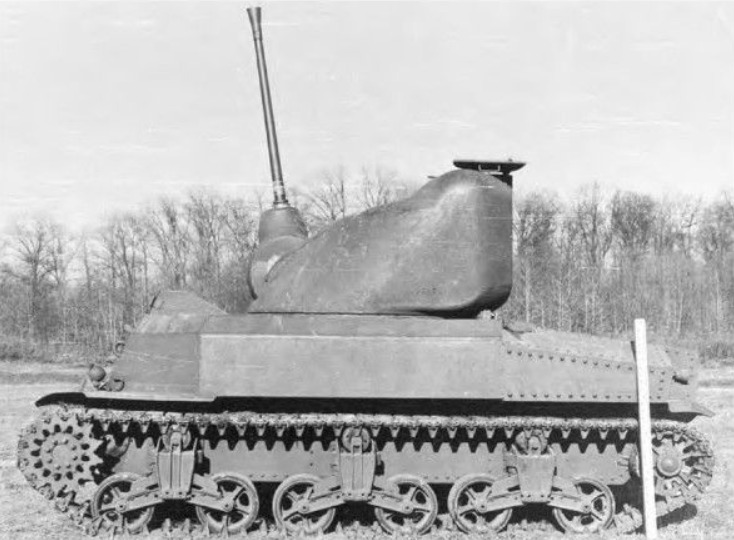 The T36 Gun Motor Carriage.
The T36 Gun Motor Carriage.
In early 1942, the US Ordnance Department and Army Ground Forces laid out requirements for a new self-propelled anti-aircraft gun based on the M4 Sherman. It was to be armed with an automatic 40 mm cannon, and two .50 caliber machine guns.
Firestone Tire and Rubber Company had already designed a turret that could fulfil these requirements, and so it was ordered for testing. Firestone finished the first turret in October 1942, and tests began with the completed vehicle – the Carriage, Motor, 40 mm Gun, T52 – in March 1943.
The T52’s Weird Turret
What Firestone had designed was a strange ball-like turret that was separated into two main parts. The lower part sat in the Sherman’s turret ring, and controlled the turret’s lateral movement.
The upper part sat within this and pivoted up and down on a trunnion for the turret’s vertical movement.
The T52’s main armament was a 40 mm M1 gun, the US version of the Bofors 40 mm anti-aircraft gun. It was mounted in the center of the turret, and had a rate of fire of just under 100 rounds per minute.
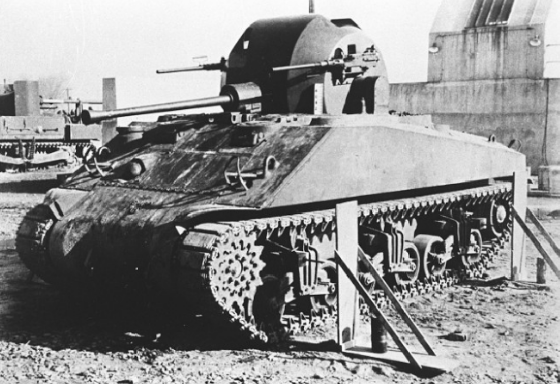 The T52 Multiple Gun Motor Carriage. In the background, a T53E1 90 mm gun motor carriage can be seen.
The T52 Multiple Gun Motor Carriage. In the background, a T53E1 90 mm gun motor carriage can be seen.
The 40 mm was supplied with only 64 rounds.
On either side of the turret was a .50 caliber machine gun, with 1,000 rounds of ammunition carried on board.
The turret was protected by 1.5 inches (38 mm) of steel, which is actually quite a respectable amount for the role.
In total, a crew of four operated the T52. Two were situated in the left and right sides of the hull front, as in a standard Sherman, while a gunner and a loader were located in the turret.
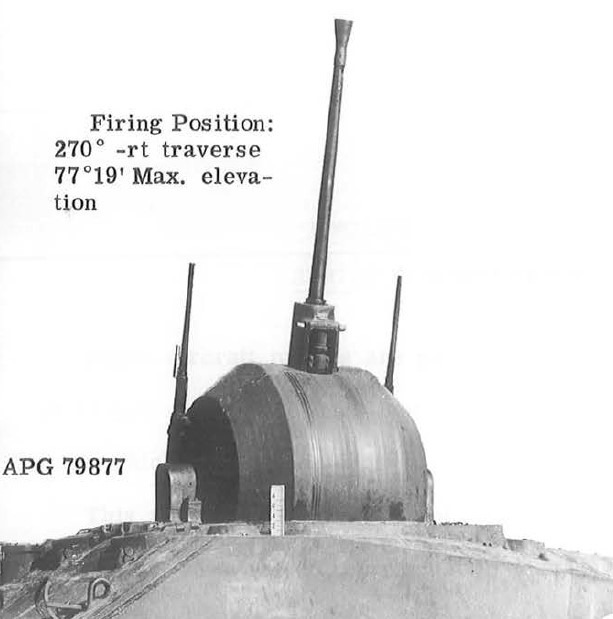 The turret functioned in a similar way to the B-17 Flying Fortress’ famous ball turret.
The turret functioned in a similar way to the B-17 Flying Fortress’ famous ball turret.Only having two in the turret was a serious limitation for the T52. The gunner was positioned on the right of the turret and had to operate the guns, but he also had to reload the .50 caliber machine gun to his right.
Meanwhile, the loader had it even worse. Naturally, he was tasked with loading the 40 mm and the left-side .50 caliber machine gun, but he also had to spot targets for the gunner, set the range for the guns, and manage any stoppages.
Other than this the T52 seems to have been based on a relatively standard M4A2 Sherman hull.
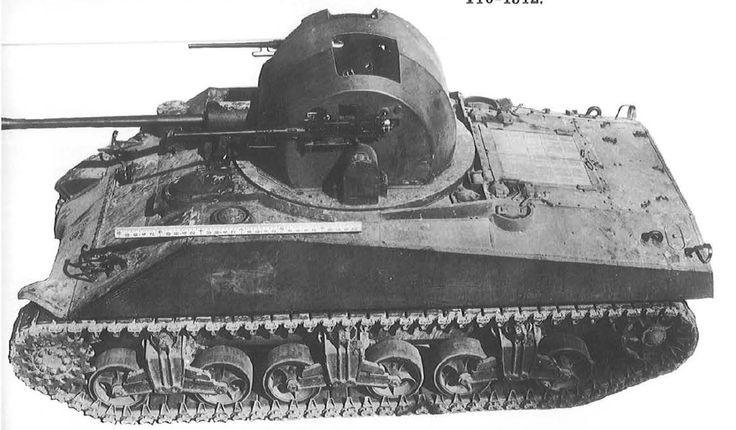 The engine deck shows this was an M4A2. Also, note the early M3-style suspension bogies, with the centrally-positioned return rollers.
The engine deck shows this was an M4A2. Also, note the early M3-style suspension bogies, with the centrally-positioned return rollers.
A Poor Design
During its evaluations at the Aberdeen Proving Ground, the T52 was found to be unsatisfactory for quite a large list of reasons; namely, the poor crew conditions.
The loader in particular simply had too many tasks to handle at once, and it was a job that really should have been divided between two people.
But even the gunner was lumped with loading a .50 caliber when it ran dry. In actual combat it’s unlikely the gunner would stop firing at an incoming aircraft for the sake of a single .50 caliber, but this would then reduce the total volume of fire.
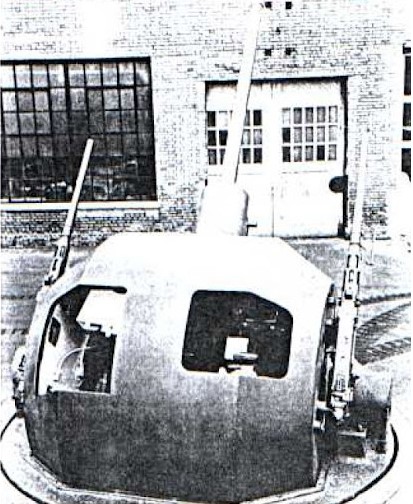 The crew’s hatches in the rear of the turret. The gunner sat on the right, and the loader sat on the left.
The crew’s hatches in the rear of the turret. The gunner sat on the right, and the loader sat on the left.
In addition, the turret was poorly designed for maintenance. The machine guns were difficult to reach, and the 40 mm’s breach almost touched the rear turret wall, limiting access. And, the .50 caliber machine guns’ spent casings could jam the turret completely.
The crew hatches were also deemed too small, and recommendations were made to increase them to improve the crew’s ability to escape.
 This might be the last photo of the T52. It was taken in 1947.
This might be the last photo of the T52. It was taken in 1947.
But the biggest problem was that the turret’s movement speed was simply too slow to properly track aircraft. This issue would have only gotten worse as aircraft got faster.
In November 1944 the project was cancelled, and the prototype was likely scrapped. Interestingly, the scrapping didn’t occur for quite some time, as one photo shows the T52 at the Aberdeen Proving Grounds in early 1947.
News
The Hanging Temple: China’s 1,500-Year-Old Cliffside Marvel of Faith and Engineering
The Hanging Temple: China’s 1,500-Year-Old Cliffside Marvel of Faith and Engineering Perched precariously on the cliffs of Mount Heng in Shanxi Province, China, the Hanging Temple, also known as Xuankong Temple, Hengshan Hanging Temple, or Hanging Monastery, is an architectural…
The Willendorf Venus: A 30,000-Year-Old Masterpiece Reveals Astonishing Secrets
The Willendorf Venus: A 30,000-Year-Old Masterpiece Reveals Astonishing Secrets The “Willendorf Venus” stands as one of the most revered archaeological treasures from the Upper Paleolithic era. Discovered in 1908 by scientist Johann Veran near Willendorf, Austria, this small yet profound…
Unveiling the Maya: Hallucinogens and Rituals Beneath the Yucatán Ball Courts
Unveiling the Maya: Hallucinogens and Rituals Beneath the Yucatán Ball Courts New archaeological research has uncovered intriguing insights into the ritual practices of the ancient Maya civilization. The focus of this study is a ceremonial offering found beneath the sediment…
Uncovering the Oldest Agricultural Machine: The Threshing Sledge’s Neolithic Origins
Uncovering the Oldest Agricultural Machine: The Threshing Sledge’s Neolithic Origins The history of agricultural innovation is a fascinating journey that spans thousands of years, and one of the earliest known agricultural machines is the threshing sledge. Recently, a groundbreaking study…
Nara’s Ancient Sword: A 1,600-Year-Old Protector Against Evil Spirits
Nara’s Ancient Sword: A 1,600-Year-Old Protector Against Evil Spirits In a remarkable discovery that has captured the attention of archaeologists and historians alike, a 7.5-foot-long iron sword was unearthed from a 1,600-year-old burial mound in Nara, Japan. This oversized weapon,…
The Inflatable Plane, Dropped Behind the Lines for Downed Pilots
Experimental The Inflatable Plane, Dropped Behind the Lines for Downed Pilots The Inflatoplane from Goodyear was an unconventional aircraft developed by the Goodyear Aircraft Company, a branch of the renowned Goodyear Tire and Rubber Company, also famed for the Goodyear…
End of content
No more pages to load











